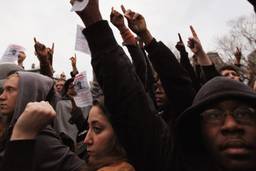(Updated 12:55 PM)
Hundreds of protesters at Occupy Oakland turned out for a showdown with police early Tuesday morning in what @OccupyOakland described as a “surprise assault” by police that included the use of tear gas, rubber bullets, and flash bang grenades, which left “many injured.”
In a scene that could have been lifted from a dystopian film, officers wearing gas masks advanced on protesters, firing rubber bullets and tear gas during the siege. (Photos of police dismantling the camp)
Local media reported that hundreds of police showed up decked in riot gear at around 4:40 a.m. and surrounded the occupation site at Frank H. Ogawa Plaza, which protesters refer to as “Oscar Grant Plaza” after the young man gunned down in cold blood by a Bart Area Rapid Transit (BART) police officer. (Video of the tear gas cloud at 17:30).
A still of the tear gas cloud (via Think Progress):

In the video at the link, the cameraman can be heard referring to a “sonic cannon” he spots in the back of a police vehicle. Sound cannons are police weaponry that emit a warning tone higher than the normal human threshold of pain. The weapon is capable of permanently damaging hearing.
Here’s some video of a version of the sound cannon, a Long Range Acoustic Device (LRAD,) being used for the first time in the U.S. in 2009 during the G20 summit in Pittsburgh. (Warning: Naturally, it’s not a very pleasant noise. I don’t think my cat is ever going to forgive me for playing this video in her presence):
If what is shown on the video is indeed a sound cannon, the police decided they didn’t need the weaponry this morning and instead relied on good, old-fashioned rubber bullets and tear gas.
CBS covering the arrests:
The Oakland Tribune reports police successfully demolished the camp, and cleaned out the tents, a medical desk, and a makeshift kitchen, among other things after declaring the camp a “crime scene,” even though, once again, the worst crime perpetrated was “unlawful assembly.” Occupy Oakland reports that around 70 people were arrested.
I’ve been lamenting in this blog about the loss of public space and the disappearing rights of protesters to assemble and voice their grievances. Oakland is another perfect example of the growing police state in the United States. Of course, Oakland has been under the authoritarian thumb of police for decades now with the execution of Oscar Grant being the one of the most recent vivid, and brutal, examples of not only the ballooning police state, but also the injustice African-Americans face on a daily basis.
But today Oakland also served to remind us of another way police encroach on civil liberties: dictating when and where Americans are “free” to exercise their First Amendment rights. Journalist Sarah Jaffe tweeted that a protester could be heard asking on Occupy Oakland’s livestream, “Are we free to walk the public streets yet?” The indifferent reply speaks volumes: “No.”
Nor were protesters free to assemble at Snow Park camp, a second site near Lake Merritt. Dozens of police moved into the camp at 6:15 a.m., ripping down tents as protesters shouted, “go away, go away,” “police state, police state,” and “rise up, rise up, against your masters.”
At 6:40, police closed the 12th Street BART station because of the protests and AC Transit started re-routing buses downtown. As of about thirty minutes ago, Occupy Oakland was calling upon its supporters to reoccupy Snow Park.
—
Update: I just spoke with Susie Cagle, an independent journalist, who has been regularly observing Occupy Oakland, and who repeatedly said she was completely stunned by the use of force by the police.
Cagle was at the camp until 2 a.m. Tuesday morning when she went home to get some food. It was then that she saw a lot of action on Twitter around 3:30 a.m. about reports of police mobilizing. Cagle got back to the camp around 4 a.m. and discovered it had been barricaded by protesters.
She hopped the barricades to check out the inside of the camp. That’s when she heard the “roar” of OPD motorcycles, quickly hopped back over the barricades, and crossed the street where she began filming the police using tear gas against the protesters.
Cagle emphasizes how completely unexpected the attack was. “We knew they were going to mobilize forces, but we weren’t expecting it today,” she says.
Oakland Police Chief Howard Jordan held a press conference about twenty minutes ago in which he admitted to the use of tear gas and rubber bullets by police, and also made reference to activists cooking with open flames, which I guess is meant to explain the use of swat team tactics, including tear gas, rubber bullets, and flash grenades.
Side-note: rubber bullets are sometimes viewed by the public as the softer, kinder approach to policing, but they can, in fact, kill people if used by under-trained officers.
“Many [officers] had what looked like rifles – huge guns – that didn’t have the wide barrels that the bean gun ones have. They looked like they could be used for rubber bullets,” Cagle says. “I’m still not sure what they were trying to get out of tear-gasing all of the people who were there to document what was happening. A little short-sighted.”
When I asked Cagle if Occupy Oakland would try to reoccupy the camp tonight, she didn’t seem optimistic. “I’m sure they’ll try. I’m sure they’ll be unsuccessful,” she says.
The “worst case scenario” discussed last night at the G.A. was to meet at the downtown main library at 4 p.m. this afternoon and to march back to the plaza. But Cagle reports that now police are telling people not to come to work downtown, so it seems as though the plaza area is still very much under surveillance, which would make retaking the camp’s old site tonight virtually impossible.
“I really wasn’t expecting this from them,” Cagle says again after a long pause. “There was so much weird tiptoeing and particular choices of language in the letters that they were sending in the eviction notices….Some of the reports I’m seeing are saying there was no line of communication between the camp and the city, and what I’ve heard from many people in the camp is that’s just not true.”
Cagle ponders if the problem might have been the lack of an “official” line of communication. The Occupy movements are leaderless, and as such, they don’t have a single representative who can meet with city officials and discuss negotiations. That might have panicked city officials who were unclear as to what the group’s planned actions were.




